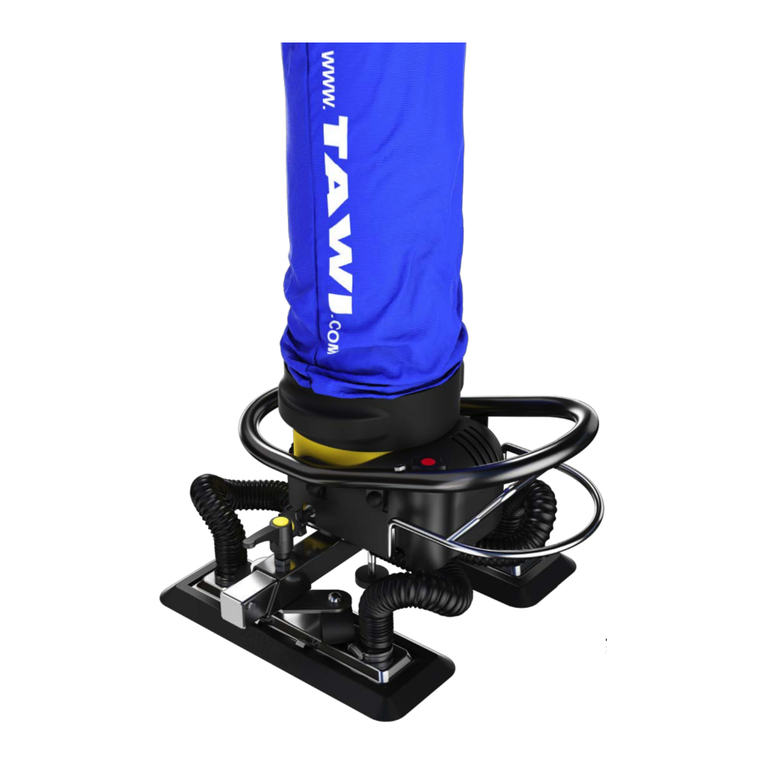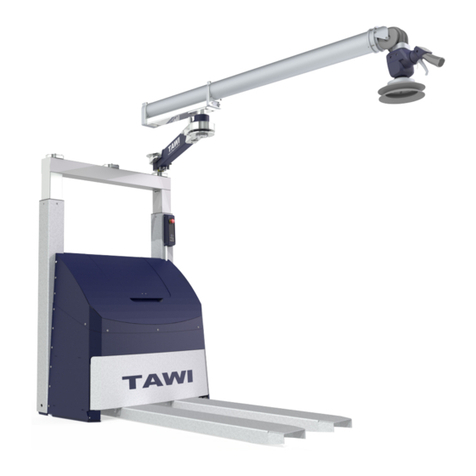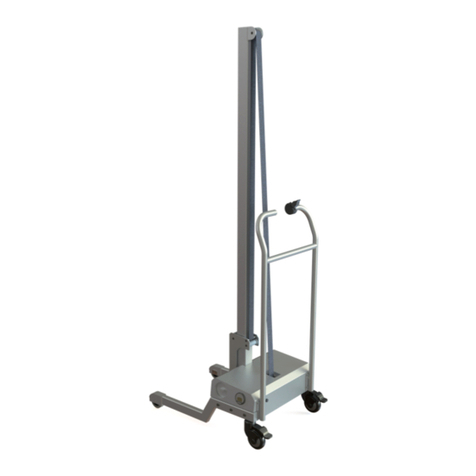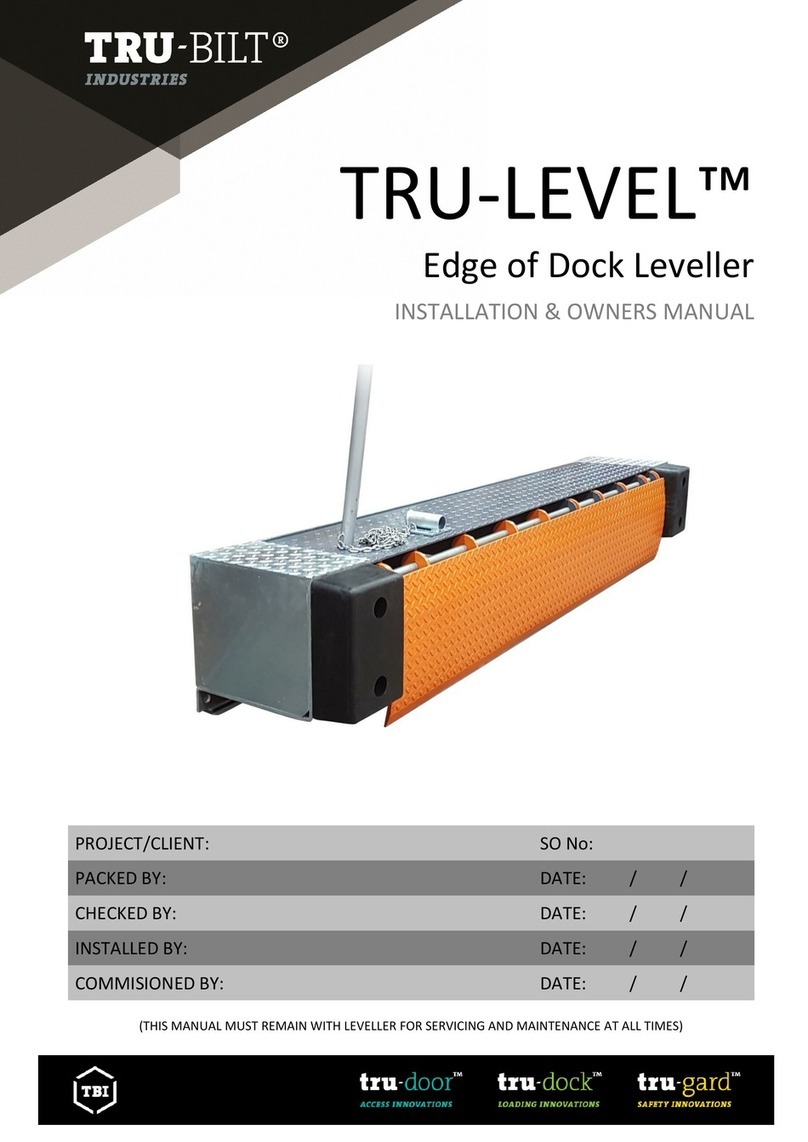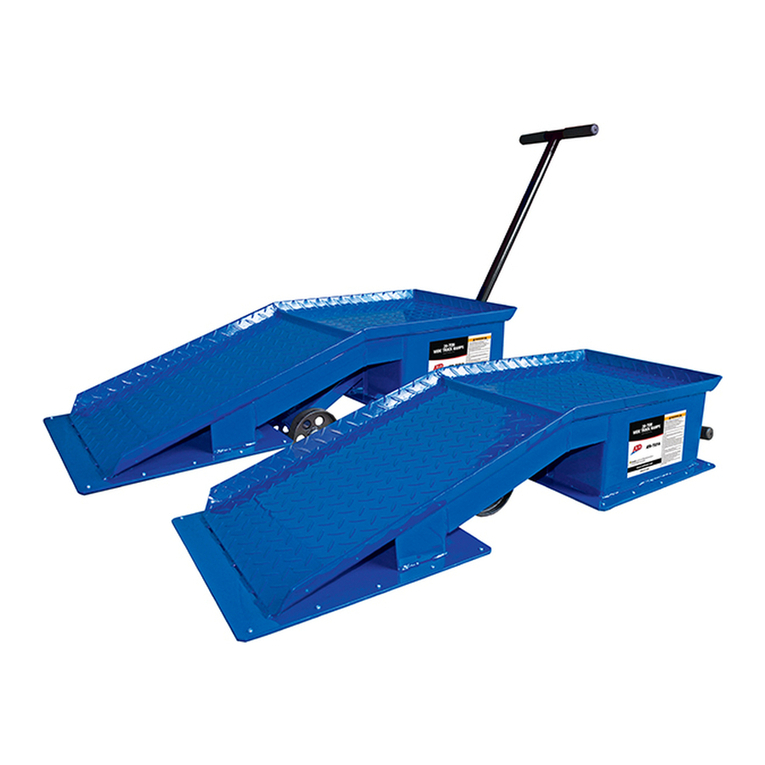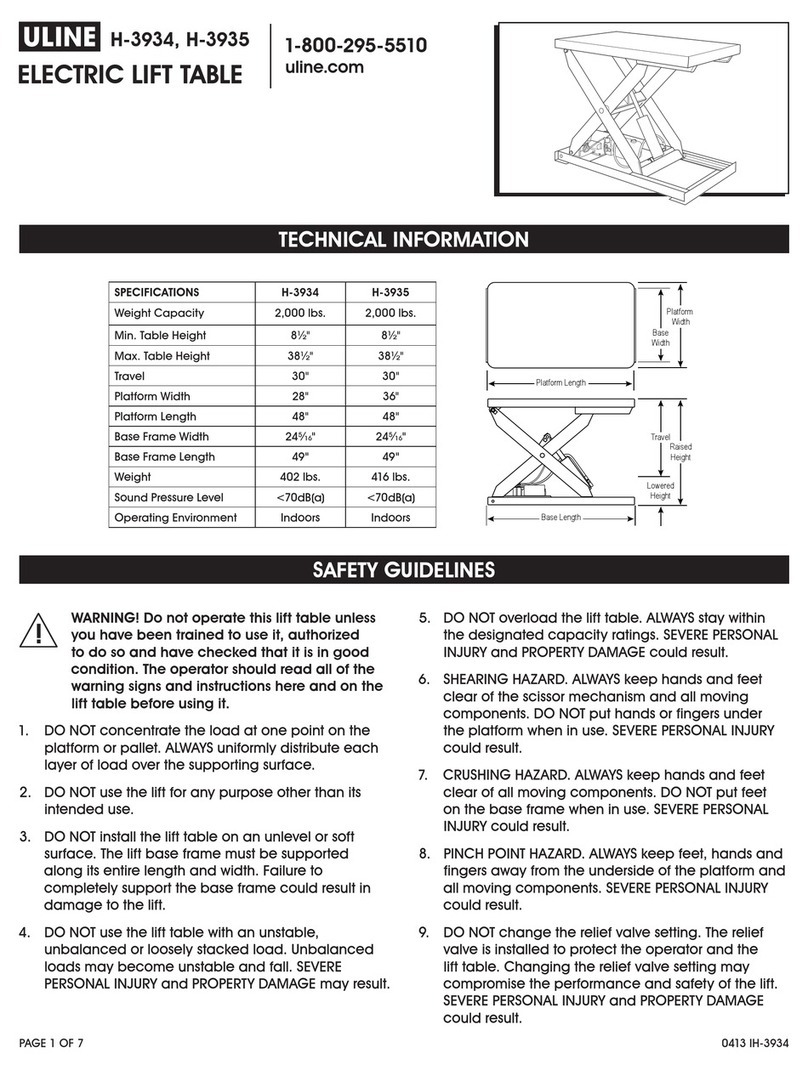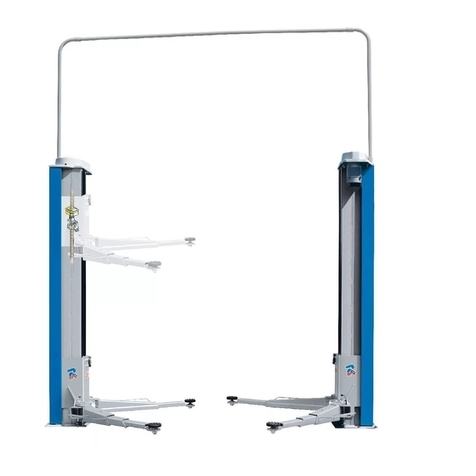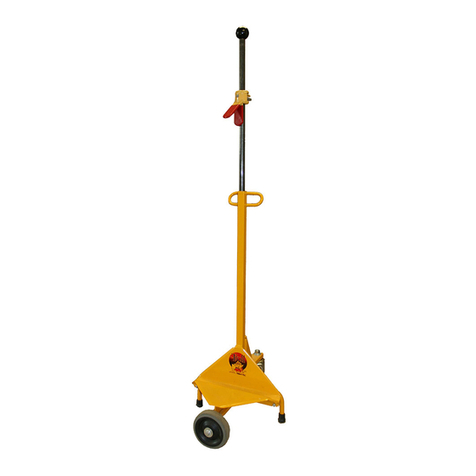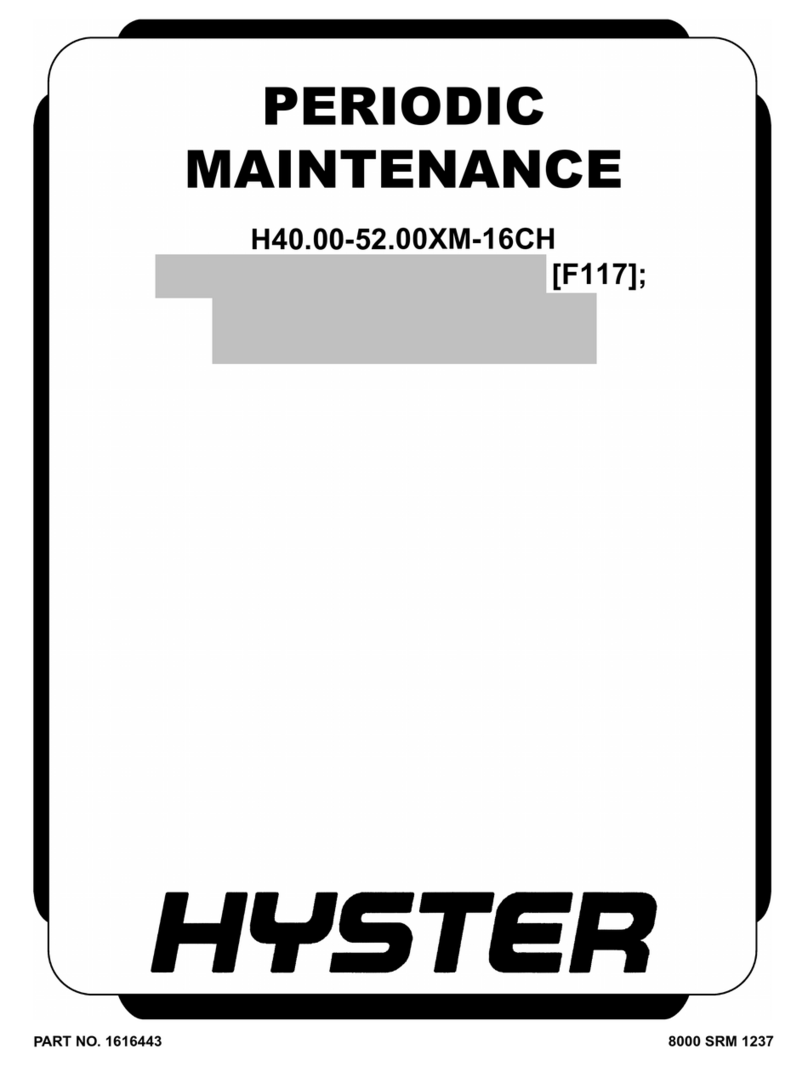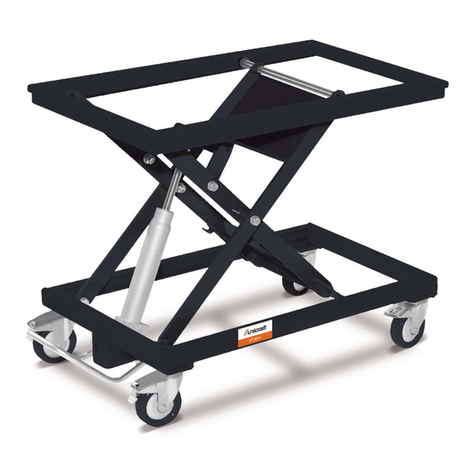TAWI Light60 User manual

TAWI Lightweight Lifting Trolley
This is the original version of the TAWI High Frequency Lifter user manual.

Manufacturer:
Business name: TAWI AB
Address: Transportgatan 1, 434 23 Kungsbacka, Sweden
Hereby declares that:
Type of machinery: Lifting Trolle
y
Product name:
Light60
Complies with the requirements of Machinery Directive 2006/42/EC
Complies also with applicable requirements of the following EC directives:
2014/30/EU
2011/65/EU (RoHS)
The following other standards and specifications have been applied:
EN ISO 12100:2010
EN 349+A1:2008
ISO 22915-16:2015
EN ISO 3691-5:2015
EN 12895:2015
EN 1175-1+A1:2010
EN ISO 13849-1:2008
EN 60204-1
Person authorized to compile the technical file:
Name: David Ranfal
k
Business name: TAWI AB
Address: Transportgatan 1, 434 23 Kungsbacka, Sweden
Signature:
Place and date: Kungsbacka 2021-02-01
Name: Thomas Bräutigam
Position: President Lifting Automation Division
EC DECLARATION OF CONFORMITY OF THE MACHINERY
Original
Directive 2006/42/EC, Annex II, A
This declaration is applicable only if the product(s) has/have been installed according to TAWI’s
instructions and provided that the product(s) has/have not been modified in any way.

Contents
1 Safety & important information 04
WEEE, RoHS and REACH 07
Do not make modications 07
Markings and labels on the TAWI Light Trolley 07
2 Warranty 09
3 Overview 10
Loading 11
4 Assembly 12
Unpacking 12
Mounting 13
5 User instructions 14
Start the lifter 14
Charge the battery 14
Battery charging indicator 15
Operating panel 15
Brakes 16
6 Service & maintenance 16
Inspections 17
7 Troubleshoot 18

Page 04
1 Safety & important information
This chapter presents safety information about the TAWI Light Trolley lifter (hereafter referred to as
lifters). Some of the information is divided in Warning, Caution and Important. This division is based on
the severity of the consequences that may occur if the instructions are not followed. Stickers and labels
are explained in this chapter and information is provided about directives that TAWI follows.
This manual and the Declaration of conformity is only valid when using TAWI authorised tools.
WARNING: Risk of personal injuries or major material damages.
Caution: Risk of material damages.
Important: Important information is highlighted.

Page 05
WARNING
• Before operating a lifter, this manual must be read and understood.
• Always apply brakes to the rear wheels when loading and unloading.
• NEVER exceed the indicated max load capacity on the lifter.
• Make sure to load according to the load diagrams including y-distances. See Labels on TAWI Light
trolley and Loading on page 7-8.
• Make sure loads are distributed evenly on the platform and always load according to load diagram.
• If any unexpected movement of the lifter occurs, press emergency stop.
• In case of emergency, engage the emergency stop, see Operating panel on page 15.
• Make sure to control and solve any potential errors before resetting the emergency stop.
• The operator’s position should always be behind the lifter when it is used. From this position the
emergency stop is within reach.
• Stay clear of the area underneath a tool at all times.
• Stay clear of moving parts.
• During all service and maintenance, lay the lifter down on the oor (on its back).
• In order to deal with the lifter’s cables and wiring, a good knowledge of electricity and TAWI elec-
trical schedules of the lifters is required. Faults can cause damage to people and property.
• NEVER climb on the lifter.
• NEVER stand on the cover or any other part of the lifter.
• It must never be used to lift living humans or animals.
Caution
• The lifters are made for indoor use on a smooth, even oor/surface. Max allowed inclination is 4%.
• The recommended temperature range for the lifters is 10 - 50°C (50 - 122°F). The lifting performance
may vary when the temperature deviates from 20°C (68°F).
• Make sure there is good lighting in areas where the lifter is operated.
• Use caution when passing over thresholds, oor drains, hoses or cables.
• Never spray or pour water onto the casing containing the battery, charger and motor. Clean with a
damp cloth only.
• Recharge the battery in a designated dry area.
• Any part of this lifter or accessories that show signs of wear or other damage must be replaced
immediately. The lifter must not be used before the damaged part is replaced.
• Do not use the lifter while it is plugged into an outlet.
• Only run the lifter when it is completely assembled.
• Wear steel toe shoes with good grip when operating the lifter.
• NEVER adjust the limit switch setting on the limit switch module.

Page 06
Important
• To prevent damages and injuries caused by improper use and not to compromise the warranty and
liability: Follow the instructions in this manual at all times!
• Keep this manual accessible to all sta.
• The lifters are not intended for use by persons (including children) with reduced physical, senses or
mental capabilities, or lack of experience or knowledge, unless they have been given supervision or
instruction concerning use of the appliance by a person responsible for their safety. Children should
be supervised to ensure that they do not play with the lifters.
• Use only TAWI original spare parts.
• Always follow any local/national recommendations as well as the instructions in this manual.
• The lifter should only be used when they are in perfect working order.
• If the lifter is to be out of use for a longer period, ensure that the battery is connected to an outlet
for the charger to maintain the battert.
• Intermittent-duty: 10%.
• Emission sound pressure level: <70 dB (A).
• The lifters max load capacity has been tested with 10% dynamic overload and 25% static overload.

Page 07
WEEE, RoHS and REACH
TAWI follows the WEEE (Directive 2012/19/EU), RoHS (2011/65/EU) and REACH (EC 1907/2006)
regulations.
A used battery and/or circuit board should either be returned to an authorised TAWI/Lifting Light
Trolley representative or handed over to a station for chemical waste. All other parts can be discarded
and assorted for recycling.
Do not make modications
Welding and other mechanical modications to TAWI Light Trolley or accessories must be carried out
by TAWI authorised sta. According to ISO 3691-5, only if TAWI is no longer in business and there
is no successor interested in the business, the user may perform a modication/alteration to a TAWI
Light Trolley. If this is done, the modication/alteration must be designed, tested and implemented
by experts in TAWI Light Trolley and their safety. Also, a permanent record of the design, test(s) and
implementation of the modication/alteration must be maintained. Appropriate changes to the capaci-
ty stickers, labels and user manual must be made, see Markings and labels on the TAWI Light Trolley. A
permanent and visible label must be fastened on the lifter that states how the lifter has been modied/
altered together with the date it was performed. The name and address of the organisation that per-
formed the modication must also be included.
Markings and labels on the TAWI Light Trolley
Identication plate Tool Identication plate
.

Page 08
Do not use as a passenger lift! Do not
stand underneath a raised tool.
Risk of hands and feet getting caught
in machine! Do not put hands or ngers
on the mast or close to the sleigh or
belt. Risk of crushing/pinching!
Do not stand on or rest your feet on the
legs or battery casing!
This symbol precedes stated max load
capacity. Never exceed the indicated
max load capacity! Also see Loading on
page 09 for information on how to load.
Labels on TAWI Light Trolley
Always transport the lifter with the load
LOWERED Disconnect power supply before
servicing.
Read manual instructions! The oper-
ator must read and understand this
manual before using the lifter.
Take precaution!

Page 09
This chapter presents warranty information about the TAWI Light Trolley .
If a TAWI Light Trolley is used according to all instructions in this manual it will perform well for many
years. TAWI oers a one year limited guarantee, excluding transportation charges, provided that the
lifter has been used under normal working conditions (one shift and then recharged) and in accordance
with the instructions in this manual. Non compliance with rules and instructions in this manual will
result in complete exclusion of TAWI´s liability.
Please contact your TAWI representative for further information.
2 Warrant

Page 10
3 Overview
a
b
d e
j
i
f
g
c
h
a. Mast
b. Control panel
c. Emergency stop
d. Leg
e. Identication plate
f. Rear wheels with brakes
g. Battery charging indicator
h. Handle
i. Platform
j. Front wheels

Page 11
Loading
The max lifting capacity of the lifters depends on where the mass centre of the load is located in terms
of x. The graphs in the load diagram display allowed x-distances.
Description Specications
Lifting capacity 60kg
Min/max lifting height 120mm - 1705mm
Weight of unit 35kg
Total height of unit 1980mm
Battery charger 100-240V, 40W, 50-60Hz
Battery 2×12V 7Ah
Lifts per charge 60kg x 1m x 100 times
Up and down motions Push buttons
Front wheels Swiveling
Brake system Individually brake rear wheels
Overload protection Individually in curcuit board
Lifting speed 125mm/s

Page 12
4 Assembly
This chapter presents what comes in the package and how to assemble the trolley and fasten the tool.
The following images shows how to fasten the legs and the platform to the base unit.
a b
c
d
e
f
g
Unpacking
a. 1 x Base unit
b. 4 x Screw covers
c. 3 x M6 screws (platform)
d. 4 x M10 screws (legs)
e. 1 x Platform
f. 3 x Power cables, US/EU/UK socket
g. 2 x Legs with wheels mounted

Page 13
• Make sure the screws are fastened correctly and that the correct torque is applied on each
screw.
2. Fasten the platform
1. Fasten the legs
Mounting
Following is images of how to fasten the legs and the platform. The following images shows how to
fasten the legs and the platform to the base unit.vthe legs and the platform to the base unit.
• See the torque table on page 17.

Page 14
Charge the battery
The battery can not be charged too often. It is recommended to charge the battery as soon as it is not
in use. full charging cycle takes 8h.
• Never use a damaged powercord, it can lead to electrical shock! Replace it immediately!
• Never touch any parts inside the battery pack when charging. Touching electrical parts can
cause an electric shock.
Start the lifter
• The lifter can be stopped at any time by pressing the emergency stop on the control panel.
• Only run the lifter when it is completely assembled.
• Check the lifter for safe functionality prior to each use, for instructions.
• The lifters has overload protection which will prevent tools from being raised when the specied
max load is exceeded. If the overload protection is activated, reduce the load and try again.
5 User instructions
This chapter describes how to operate the TAWI Light Lifting Trolley.

Page 15
Battery charging indicator
The color of the battery charging indicator communicates the following information:
Operating panel
Grab the handles and push the lifter to move
it forward.
To move the platform up and down push the
buttons a and c.
The emergency button is found in the middle
of the control panel, b.
• Always move the lifter with the load in a lowered position.
• If platform is lowered onto an object and is prevented from beeing lowered further down,
will belt still run. If belt hasn't fully tension there is a risk of platform falling down if object is
removed.
a b c
• Make sure that the load is stable and secured on the platform.
• Make sure the platform is loaded according to the load diagram at page 14.
• The lifter can be switched on or o when charging the battery. It is recommended that the lifter
is switched o when not in use.
• To make sure not to damage the cord when pulling it out of the electrical outlet - grab, and apply
the force to the plug. To prevent damage to the cord, never pull the cord itself always pull on the
plug.
• It is recommended to charge the battery in a full cycle.
• Never operate the lifter when the battery is charging (plugged in).
• Charge the battery in a designated dry area.
• Normal charging of the battery creates very small amounts of hydrogen. However, the casing is
ventilated, and thereby the risk of hydrogen collection is minimal.
Red Chargin
Green Ready/Standby
a. Down
b. Emergency stop
c. Up

Page 16
If a tool hits an object or surface during lowering, a safety mechanism will stop the downwards
movement. This is to prevent accidents.
• Always apply brakes when loading and unloading.
Brakes
Rear wheels separately braked
Engage or disengage the brakes on both rear
wheels.
a. Neutral
b. Brake
a b
• Service must be carried out on a yearly basis.
• If any damage/wear is detected on the lifter, this must immediately be reported to TAWI or au-
thorisedTAWI representative. The lifter must be taken out of commission and not be used until
the damage has been repaired.
• All service must be carried out with the battery disconnected.
• In order to deal with the lifter’s cables and wiring, a good knowledge of electricity and TAWI
electrical schedules of the lifters is required.
• If the battery needs to be replaced, make sure that an original battery is used. If assistance is
needed, contact TAWI.
• Keep the lifter clean, use a damp cloth. Do not use chemical cleaners.
6 Service & maintenance
This chapter provides information about service and maintenance of the lifters. The chapter is divided
into three sections based on who is to perform the inspections and how often the inspections are to
be carried out. Daily by the operator, quarterly by inhouse maintenance and yearly by PIAB authorised
service technician. For technical service, maintenance or repairs contact your PIAB representative or
la.info@piab.com. PIAB must authorise all modications to this product. PIAB assumes no responsibility
for unauthorised modications and guarantees will automatically become invalid if unauthorised modi-
cations have been made.

Page 17
Inspections
The following inspections are to be carried out.
1. Double check (carry out) all daily inspections mentioned in Daily inspections by operator.
2. Check all screws and nuts for damage/wear.
Quarterly inspections by inhouse maintenance
1. Check that CE mark and serial number on the identication plate are visible.
2. Make sure all screws and nuts are tightened according to Torques to apply on page 17 (Pay extra attention
to screws and nuts on mast, legs and tool attachments).
3. Check belt wheels for signs of damage/wear.
4. Check the belt for wear and tear and make sure that it is properly secured.
5. Check belt wheels for signs of damage/wear.
6. Check the belt for wear and tear and make sure that it is properly secured.
7. Make sure that upper and lower switches are functioning correctly.
8. Control that the battery voltage level is sufficient.
9. Control that the charger is supplying correct voltage.
10. Check all wiring for signs of damage/wear and make sure all connections are correct.
11. Control screws and safety functions on tool.
12. Control welds for damage/wear on legs and tools caused by misuse, overload etc.
Torque table
Daily inspections by Operator
Type M5 M6 M8 M10
Torque (Nm, class 8.8) (ft/lb) 6 Nm (4.4 ft/lb) 10 Nm (7.3 ft/lb) 24 Nm (17.7 ft/lb) 47 Nm (34.6 ft/lb)
1. Check that the yearly maintence sticker is valid, and that yearly inspection is performed.
2. Check that the max lifting capacity signs and warning/operating labels are visible.
3. Make sure wheels/brakes are functioning correctly and check for signs of damage.
Yearly inspections by TAWI authorised service technician

Page 18
7 Troubleshoot
This chapter provides information on how to investigate or rectify problems that may occur. Actions
marked with (*) must be carried out by PIAB or a TAWI authorised service technician.
Problem Likely caused by Action required
Tool does not move up or down
Main switch is turned o. Turn main switch on.
Emergency stop is engaged. Disengage the emergency stop.
Batteries need charging. Charge batteries according to manual. See (A) on page
16.
Batteries are drained. Change batteries.*
Charger is damaged. Check if charger supplies correct voltage, if not
replace charger.*
Limit switches are broken/damaged. Check functions of limit switches, replace if
needed.*
No signal from operating panel. Check signal from the control panel to circuit
board.*
Wires or connections are loose on
battery.
Check wire connection on batteries. Connect if
necessary.
Fuse has tripped. Check fuse, replace if broken.
Circuit board damaged. Replace circuit board.*
Tool moves
slowly up/down
down
Batteries are weak. Charge batteries according to manual.
Brake does
not work
Brake has been misused. Replace rear wheels.
Charge
indicator
Charger is broken. Replace battery charger.*
*Must be carried out by authorized TAWI service technician.

1. Platform surface
2. Platform frame
3. Lifting belt
4. Battery
5. Front wheel
6. Rear wheel
7. Emergency stop
8. Up/down button
9. Top cover
10. Motor
11. Limit switch module
12. Battery charger
13. Electric control board
7
8
3
11
10
13
12
46
5
1
29
4305349
4305348
4305344
4305296
4305308
4305235
4305294
4305297
4305360
4305301
4305320
4305373
4305372

TAWI AB
Box 102 05
Transportgatan 1
434 23 Kungsbacka
Tel: +46 (0) 300 -185 00
la.info@piab.com
tawi.com
REV0 EN
A brand by Piab Group
Table of contents
Other TAWI Lifting System manuals
Popular Lifting System manuals by other brands
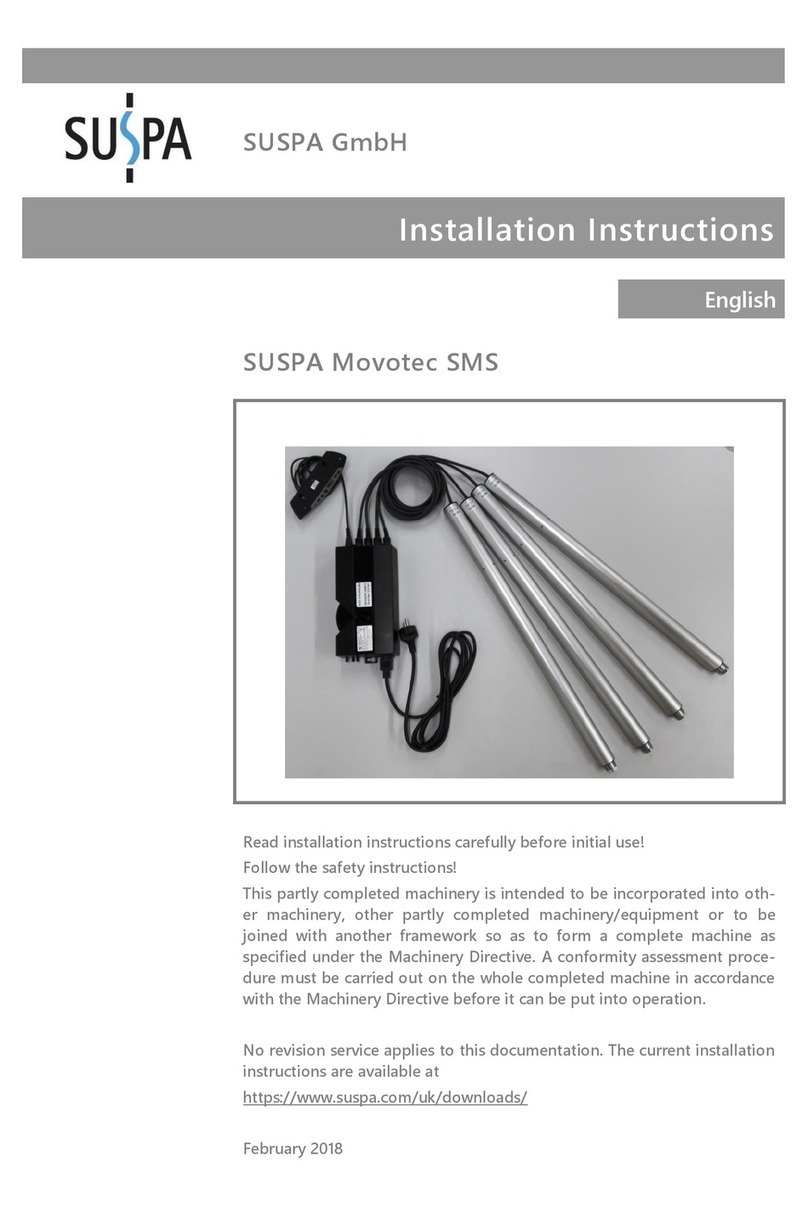
Suspa
Suspa Movotec SMS installation instructions
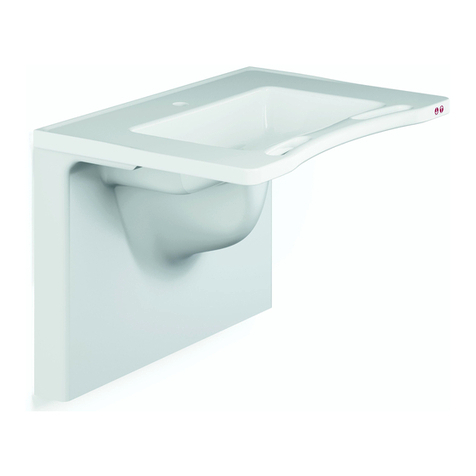
Pressalit Care
Pressalit Care R4822 Mounting instruction

Lockhard
Lockhard UP Lift 5 HD200 operating manual
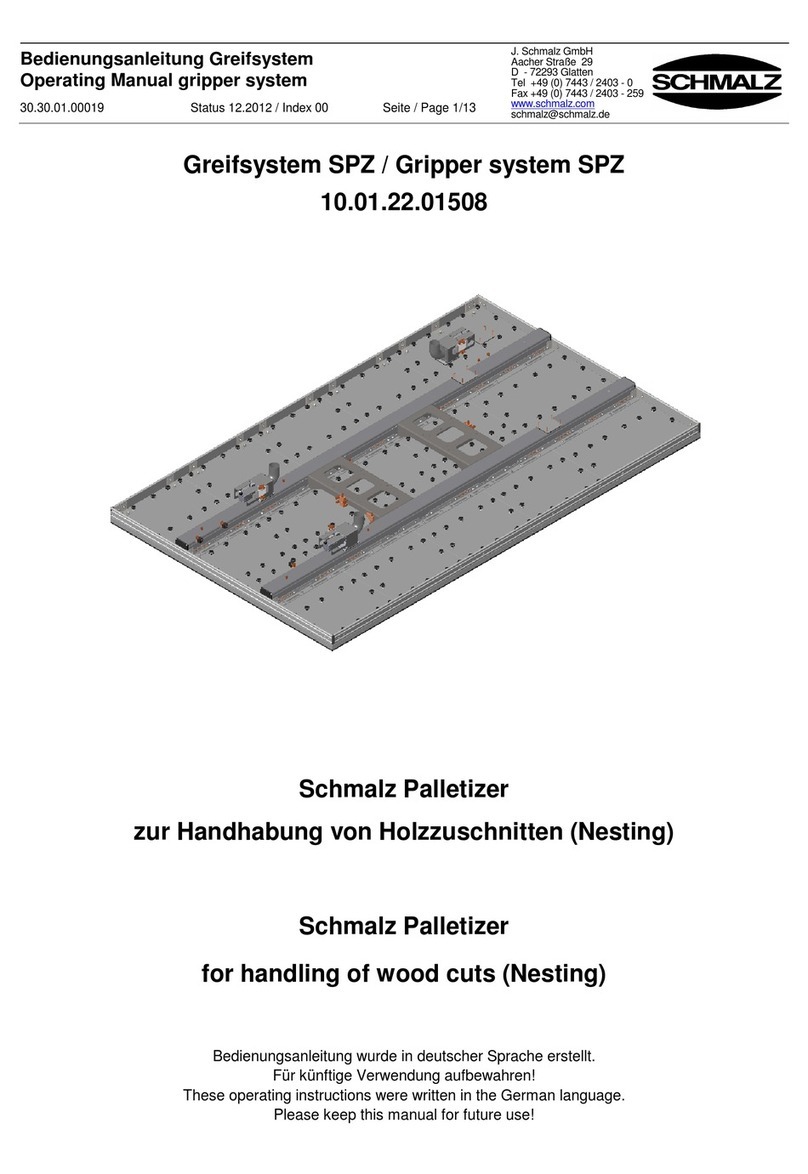
Schmalz
Schmalz SPZ Series operating manual
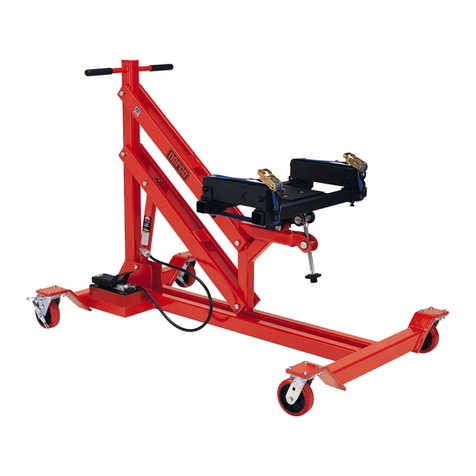
Norco
Norco 72675 Setup, operating, maintenance instructions
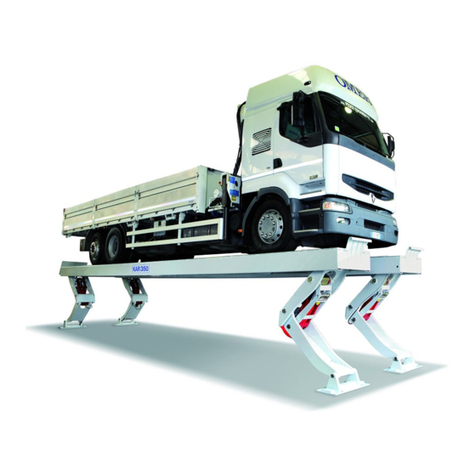
Omer
Omer Kar 350 Operation and maintenance manual
